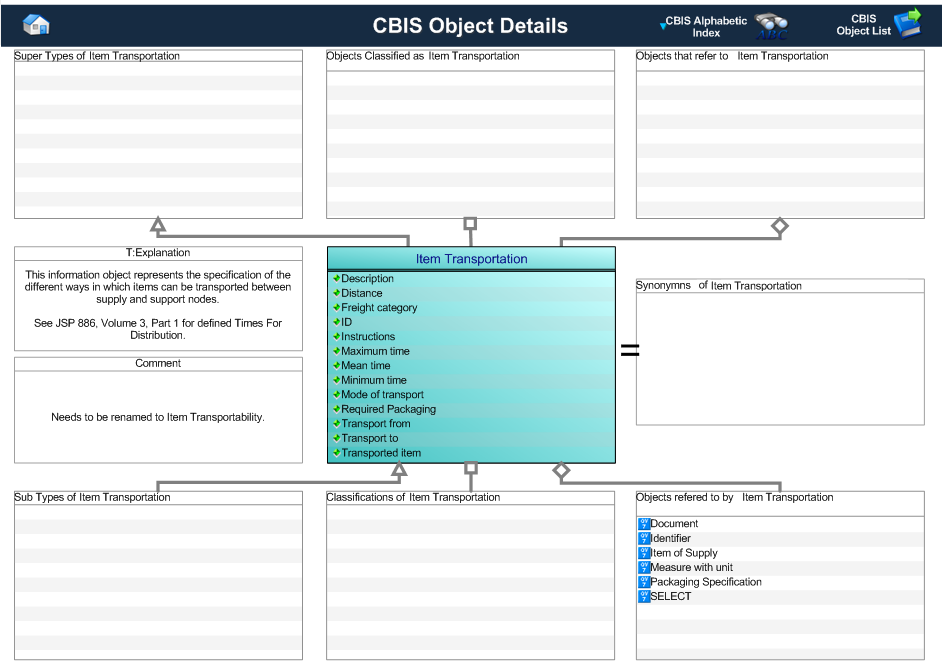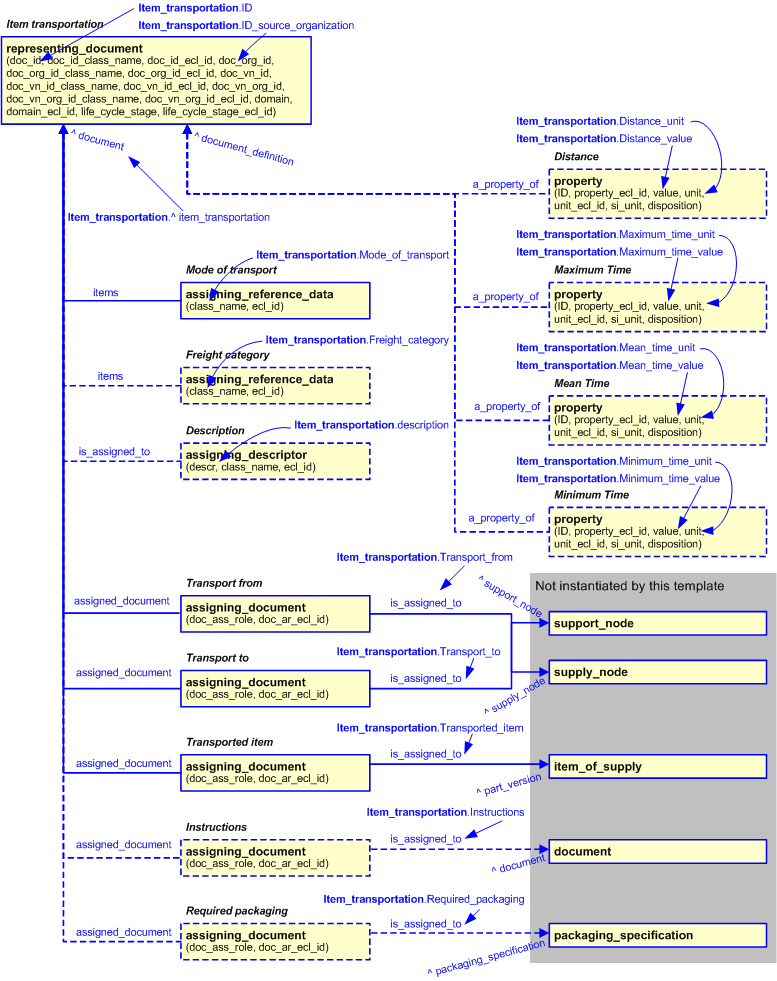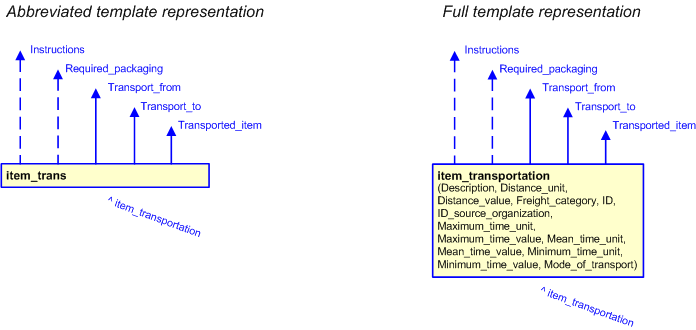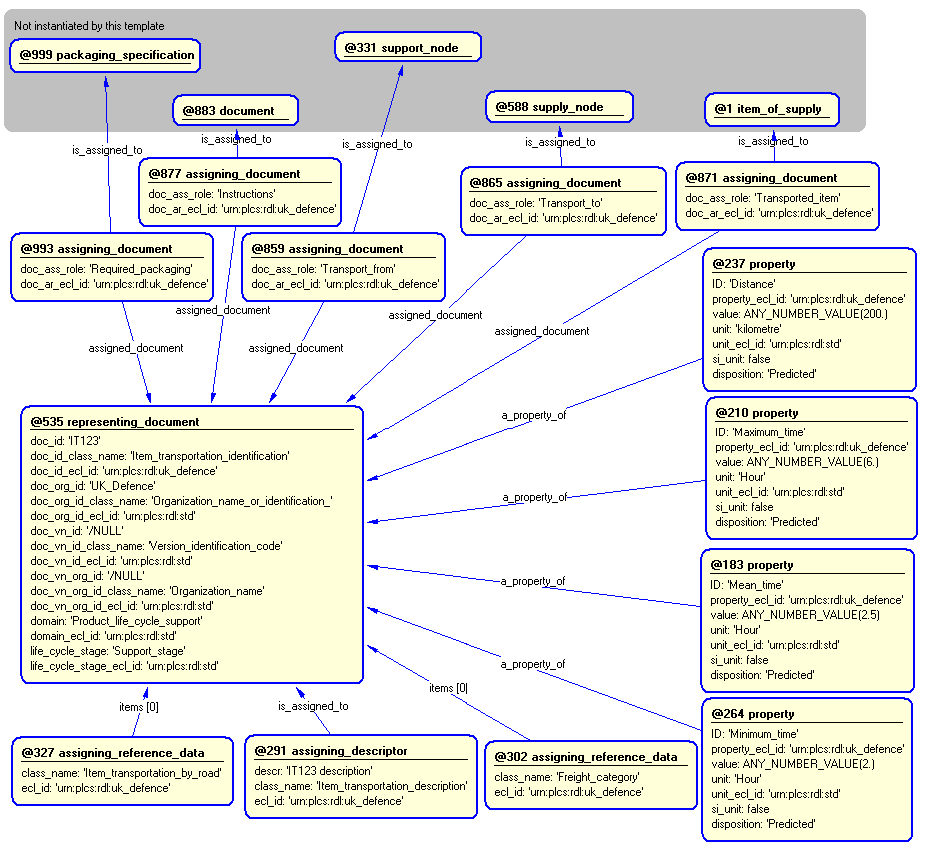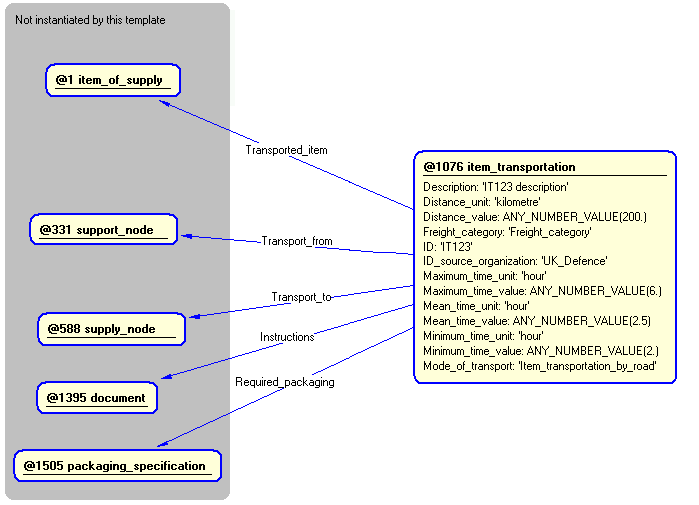Template:— item_transportation (item_trans)
Context:— UK_Defence |
Date: 2010/02/04 21:04:29
Revision: 1.4
|
This section specifies the template item_transportation.
NOTE
The template has been defined in the context of
UK_Defence.
Refer to the business context for details of related templates.
NOTE
An explanation of a template and the associated instantiation path is
provided in the
Template overview
section.
This template describes how to represent the specification of the different ways in which items can be transported between
supply and support nodes.
The item transportation context business object is used by those UK_Defence Data Exchange
Specifications that require information about different ways in which items can be transported
between supply and support nodes.
Figure 1 — Graphical Representation for Business Object Item Transportation
Item Transportation:
The definition of an Item Transportation object is:
Data about the specification of the different ways in which items can be transported between supply and support
nodes.
|
Attribute name
|
Attribute description
|
Attribute type
|
Optionality
|
| Description |
This is the description of the item transportation. |
Intrinsic |
Optional |
| Distance |
This is the distance between the origin and destination nodes, by the mode of transport. |
Measure_with_unit |
Optional |
| Freight category |
This is the category of freight which applies to the related item for the mode of transport. |
Intrinsic |
Optional |
| ID |
This is the identifier of the item transportation. |
Identifier |
Mandatory |
| Instructions |
This is the reference to the document containing any specific instructions related to the transport of the item of
supply between the supply / support nodes using the mode of transport specified.
|
Relationship to Document |
Mandatory |
| Maximum time |
This is the longest time taken to transport the item
between the origin and destination nodes, by the related mode of transport
|
Measure_with_unit |
Optional |
| Mean time |
This is the average time taken to transport the item between the
origin and destination nodes, by the related mode of transport
|
Measure_with_unit |
Optional |
| Minimum time |
This is the shortest time taken to transport the item between the
origin and destination nodes, by the related mode of transport
|
Measure_with_unit |
Optional |
| Mode of transport |
This is the category (mode) of transport that can be used for
transporting the related item.
EXAMPLE: "Road", "Air", "Sea", "Rail".
|
Intrinsic |
Mandatory |
| Required packaging |
This is the reference to the packaging specification that is required for the item of supply
being transported between the supply/support nodes using the mode of transport specified.
|
Relationship to Packaging specification |
Mandatory |
| Transport from |
This is the reference to the supply or support node from which the
item is transported
|
Relationship to Supply node or Support node |
Mandatory |
| Transport to |
This is the reference to the supply or support node to which the item is transported |
Relationship to Supply node or Support node |
Mandatory |
| Transported item |
This is the reference to the item for which the transportation is define |
Relationship to Item of Supply |
Mandatory |
Table 1 — Item Transportation attribute details
The EXPRESS-G diagram in
Figure
2
shows the templates and EXPRESS entities that are required
to represent the template
"item_transportation".
The text highlighted in blue shows the template parameters.
Figure 2 — An EXPRESS-G representation of the Information model for item_transportation
The graphic for the template to be used in other EXPRESS-G diagrams
is shown in Figure
3
below.
Figure 3 — The graphical representation of the item_transportation template
The following input parameters are defined for this template:
The description of the item transportation.
The class name corresponding to the unit in which the distance between the origin
and destination nodes, by the mode of transport.
The following classes and their sub-classes can be used:
The value of the distance between the origin and destination nodes, by the mode of transport.
The data type must also be indicated in this parameter, e.g.
"ANY_NUMBER_VALUE(5)".
The category of freight which applies to the related item for the mode of transport
The identifier of the item transportation
The organization that created the item transportation. Additionally
a Person or Information System could be defined when either of these are the source; see Identifier template.
The reference to the document containing any specific instructions related to the transport of the item of
supply between the supply / support nodes using the mode of transport specified.
The class name corresponding to the unit in which the longest time taken to transport the item
between the origin and destination nodes, by the related mode of transport.
The following classes and their sub-classes can be used:
The value of the longest time taken to transport the item
between the origin and destination nodes, by the related mode of transport
The data type must also be indicated in this parameter, e.g.
"ANY_NUMBER_VALUE(5)".
The class name corresponding to the unit in which the average time taken to transport the item between the
origin and destination nodes, by the related mode of transport.
The following classes and their sub-classes can be used:
The value of the average time taken to transport the item between the
origin and destination nodes, by the related mode of transport,
The data type must also be indicated in this parameter, e.g.
"ANY_NUMBER_VALUE(5)".
The class name corresponding to the unit in which the shortest time taken to transport the item
between the origin and destination nodes, by the related mode of transport.
The following classes and their sub-classes can be used:
The value of the shortest time taken to transport the item
between the origin and destination nodes, by the related mode of transport
The data type must also be indicated in this parameter, e.g.
"ANY_NUMBER_VALUE(5)".
The category (mode) of transport that can be used for
transporting the related item.
The following classes and their sub-classes can be used:
classifications: [Mode_of_item_transportation]![[warning:]](../../../../../../images/dex/warning.gif) Error RDL4: The URI urn:plcs:rdl:uk_defence is not listed in dexlib/data/refdata/rdl_index.xml
Error RDL4: The URI urn:plcs:rdl:uk_defence is not listed in dexlib/data/refdata/rdl_index.xml
The reference to the packaging specification that is required for the item of supply
being transported between the supply/support nodes using the mode of transport specified.
This is the reference to the supply or support node from which the item is transported
This is the reference to the supply or support node to which the item is transported
This is the reference to the item for which the transportation is define
The following reference parameters are defined for this template:
Allow the
Document
entity instantiated in this path to be referenced when this template is used.
Note: The
Document
entity can be referenced in a template path by:
%^target = $item_transportation.item_transportation%
where
target
is the parameter to which the
Document
is bound.
The following parameter combinations specify a uniqueness constraint:
Unique constraint: Item transportation
The instantiation path shown below specifies the entities that are to be
instantiated by the template.
A description of templates and the syntax for the instantiation path is
provided in the
Templates Help/Information section.
-- record /
representing_document(
doc_id=@ID,
doc_id_class_name='Item_transportation_identification',
doc_id_ecl_id='urn:plcs:rdl:uk_defence',
doc_org_id=@ID_source_organization,
doc_org_id_class_name='Organization_name_or_identification_code',
doc_org_id_ecl_id='urn:plcs:rdl:uk_defence',
doc_vn_id=/NULL,
doc_vn_id_class_name='Version_identification_code',
doc_vn_id_ecl_id='urn:plcs:rdl:std',
doc_vn_org_id='/NULL',
doc_vn_org_id_class_name='Organization_name',
doc_vn_org_id_ecl_id='urn:plcs:rdl:std',
domain='Product_life_cycle_support',
domain_ecl_id='urn:plcs:rdl:std',
life_cycle_stage='Support_stage',
life_cycle_stage_ecl_id='urn:plcs:rdl:std')/
%^item_transportation = $representing_document.document%
%^document_definition = $representing_document.document_definition%
-- [optional Description] /
assigning_descriptor(
descr=@Description,
class_name='Item_transportation_description',
ecl_id='urn:plcs:rdl:uk_defence',
is_assigned_to=^item_transportation)/
-- [ optional Distance] /
property(
a_property_of=^document_definition,
ID='Distance',
property_ecl_id='urn:plcs:rdl:uk_defence',
value=@Distance_value,
unit=@Distance_unit,
unit_ecl_id='urn:plcs:rdl:std',
si_unit='false',
disposition='Predicted')/
-- [ optional Freight category] /
assigning_reference_data(
items=^item_transportation,
class_name=@Freight_category,
ecl_id='urn:plcs:rdl:uk_defence')/
-- [ optional Maximum time] /
property(
a_property_of=^document_definition,
ID='Maximum_time',
property_ecl_id='urn:plcs:rdl:uk_defence',
value=@Maximum_time_value,
unit=@Maximum_time_unit,
unit_ecl_id='urn:plcs:rdl:std',
si_unit='false, disposition=')/
-- [ optional Mean time] /
property(
a_property_of=^document_definition,
ID='Mean_time',
property_ecl_id='urn:plcs:rdl:uk_defence',
value=@Mean_time_value,
unit=@Mean_time_unit,
unit_ecl_id='urn:plcs:rdl:std',
si_unit='false',
disposition='Predicted')/
-- [ optional Minimum time] /
property(
a_property_of=^document_definition,
ID='Minimum_time',
property_ecl_id='urn:plcs:rdl:uk_defence',
value=@Minimum_time_value,
unit=@Minimum_time_unit,
unit_ecl_id='urn:plcs:rdl:std',
si_unit='false',
disposition='Predicted')/
-- Transport from /
assigning_document(
doc_ass_role='Transport_from',
doc_ar_ecl_id='urn:plcs:rdl:uk_defence',
is_assigned_to=@Transport_from,
assigned_document=^item_transportation)/
-- Transport to /
assigning_document(
doc_ass_role='Transport_to',
doc_ar_ecl_id='urn:plcs:rdl:uk_defence',
is_assigned_to=@Transport_to,
assigned_document=^item_transportation)/
-- Transported Item /
assigning_document(
doc_ass_role='Transported_item',
doc_ar_ecl_id='urn:plcs:rdl:uk_defence',
is_assigned_to=^item_transportation,
assigned_document=@Transported_item)/
-- Mode of transport /
assigning_reference_data(
items=^item_transportation,
class_name=@Mode_of_transport,
ecl_id='urn:plcs:rdl:uk_defence')/
-- [optional Instructions] /
assigning_document(
doc_ass_role='Instructions',
doc_ar_ecl_id='urn:plcs:rdl:uk_defence',
is_assigned_to=@Instructions,
assigned_document=^item_transportation)/
-- [optional Required packaging] /
assigning_document(
doc_ass_role='Required packaging',
doc_ar_ecl_id='urn:plcs:rdl:uk_defence',
is_assigned_to=@Required_packaging,
assigned_document=^item_transportation)/
The instance diagram in Figure
4
shows an example of the EXPRESS entities and templates that are instantiated by the template:
/item_transportation(Description='IT123 description', Distance_unit='kilometre', Distance_value='ANY_NUMBER_VALUE(200)', Freight_category='Freight_category', ID='IT123', ID_source_organization='UK_Defence', Instructions='@', Maximum_time_unit='Hour', Maximum_time_value='6', Mean_time_unit='Hour', Mean_time_value='2.5', Minimum_time_unit='Hour', Minimum_time_value='2', Mode_of_transport='Item_transportation_by_road', Required_packaging='@', Transport_from='@859', Transport_to='@865', Transported_item='@1')/
(an illustration of the consolidated item_transportation template is shown in
Figure
5 below.)
Figure 4 — Entities instantiated by item_transportation template
The instance diagram in
Figure
5
shows the graphic symbol for the template that is to be
used in other instance diagrams. The example template is:
/item_transportation(Description='IT123 description', Distance_unit='kilometre', Distance_value='ANY_NUMBER_VALUE(200)', Freight_category='Freight_category', ID='IT123', ID_source_organization='UK_Defence', Instructions='@', Maximum_time_unit='Hour', Maximum_time_value='6', Mean_time_unit='Hour', Mean_time_value='2.5', Minimum_time_unit='Hour', Minimum_time_value='2', Mode_of_transport='Item_transportation_by_road', Required_packaging='@', Transport_from='@859', Transport_to='@865', Transported_item='@1')/
Figure 5 — Instantiation of item_transportation template
Characterizations
No common characterizations of the template
item_transportation
have been identified. However, the ISO 10303-239 EXPRESS model
may enable other assignments to the entities instantiated by the template.
